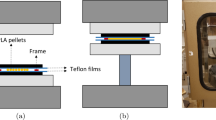Abstract
Phenomena taking place in oriented polymers (polyethylene terephthalate, polystyrene, etc.) under the influence of water lead to substantial changes in their physical and mechanical properties including strength, optical anisotropy, and density. To elucidate these phenomena and to determine the part played by each of them, we carried out tests in which heat-treated polymer-film specimens were subjected to long-term action of water. It was established that at least two processes take place simultaneously in polymer films under these conditions. One of them is associated with the relaxation of local overstresses in polymer regions characterized by a low degree of order and is accompanied by a rearrangement of structural elements in the direction of vectors of local overstresses. The other process is associated with the plasticizing action of water which weakens the forces of interaction between structural elements in the regions of a low degree of order without affecting the polymer skeleton itself. The intensity of each process is different, and this is the cause of the extremal character of the variation in physical and mechanical properties of films.
Similar content being viewed by others
References
G. G. Povarnin, Vestnik VKS,10, 504, 1928.
P. Chersa, Mod. Plast.,36, 135, 1958.
R. A. Horsley, Plast. Progr.,4, 77, 1957.
B. A. Dogadkin, D. A. Fedyukin, and V. E. Gul, Kolloidnyi zh-1,19, 287, 1957.
L. A. Volkova and M. V. Vol'kenshtein, FTT, no. 8, 1272, 1959.
P. V. Kozlov and R. V. Zueva, Trudy NIKFI, no. 7, 5, 1947.
S. A. Kazakevich, P. V. Kozlov, and A. P. Pisarenko, FKhMM [Soviet Materials Science], no. 2, 1968.
I. N. Razinskaya, B. P. Shtarkman, and P. V. Kozlov, VMS,6, 427, 1964.
E. I. Barg, Technology of Synthetic Plastics [in Russian], Goskhimizdat, 1954.
B. N. Korostylev and P. V. Kozlov, Trudy NIKFI, no. 4, 66, 1954.
V. A. Berestnev, T. V. Gatovskaya, V. A. Kargin, and E. Ya. Yaminskaya, VMS, 1, 395, 1959.
N. V. Mikhailov and E. Z. Fainberg, Kolloidnyi zh-1,16, 120, 1954.
I. F. Kaimin, Khimicheskie volokna, no. 5, 48, 1966.
B. Dolezhel, Corrosion of Plastics and Resins [Russian translation], Izd. Khimiya, 1964.
V. A. Kargin and G. L. Slonimskii, A Short Outline of Physical Chemistry of Polymers [in Russian], Izd. Khimiya, 1967.
S. A. Kazakevich, P. V. Kozlov, and A. P. Pisarenko, FKhMM [Soviet Materials Science], no. 5, 1968.
Author information
Authors and Affiliations
Additional information
Thanks are owed to N. F. Bakeev for his help in carrying out this investigation and interpreting its results.
Rights and permissions
About this article
Cite this article
Kazakevich, S.A., Kozlov, P.V. & Pisarenko, A.P. Causes of extremal variations in the strength of polymer films under the influence of water. Mater Sci 5, 55–58 (1972). https://doi.org/10.1007/BF00721310
Issue Date:
DOI: https://doi.org/10.1007/BF00721310




